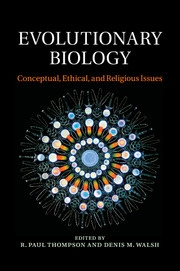
-
Select format
-
- Publisher:
- Cambridge University Press
- Publication date:
- 05 March 2014
- 13 March 2014
- ISBN:
- 9781139208796
- 9781107027015
- 9781316649671
- Dimensions:
- (228 x 152 mm)
- Weight & Pages:
- 0.51kg, 256 Pages
- Dimensions:
- (229 x 152 mm)
- Weight & Pages:
- 0.38kg, 256 Pages
- Subjects:
- Life Sciences, Evolutionary Biology, Philosophy of Science, Philosophy
You may already have access via personal or institutional login- Subjects:
- Life Sciences, Evolutionary Biology, Philosophy of Science, Philosophy
Book description
Evolution - both the fact that it occurred and the theory describing the mechanisms by which it occurred - is an intrinsic and central component in modern biology. Theodosius Dobzhansky captures this well in the much-quoted title of his 1973 paper 'Nothing in biology makes sense except in the light of evolution'. The correctness of this assertion is even more obvious today: philosophers of biology and biologists agree that the fact of evolution is undeniable and that the theory of evolution explains that fact. Such a theory has far-reaching implications. In this volume, eleven distinguished scholars address the conceptual, metaphysical and epistemological richness of the theory and its ethical and religious impact, exploring topics including DNA barcoding, three grand challenges of human evolution, functionalism, historicity, design, evolution and development, and religion and secular humanism. The volume will be of great interest to those studying philosophy of biology and evolutionary biology.
Reviews
'This volume is not just an homage to Ruse, it contains provocative and creative essays by an impressive list of all-stars in the philosophy of biology.'
Richard A. Richards Source: The Quarterly Review of Biology
Contents
Metrics
Altmetric attention score
Full text views
Full text views help Loading metrics...
Loading metrics...
* Views captured on Cambridge Core between #date#. This data will be updated every 24 hours.
Usage data cannot currently be displayed.
Accessibility standard: Unknown
Why this information is here
This section outlines the accessibility features of this content - including support for screen readers, full keyboard navigation and high-contrast display options. This may not be relevant for you.
Accessibility Information
Accessibility compliance for the PDF of this book is currently unknown and may be updated in the future.


